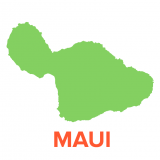The Paeahu solar farm, located in a dryland forest, would operate a short distance from a residential subdivision.
A controversial solar project in South Maui is wending its way through the approvals process with a hearing officer鈥檚 recommendation now expected next month.
The storage project would be on 200 acres of former ranchland about 250 feet mauka of the Maui Meadows subdivision. The developer, Canadian firm , plans a 15-megawatt solar farm with a 60-megawatt battery storage system capable of powering about 6,900 Maui households.
The project was supposed to start operating last year, according to the company website, but permit delays, supply chain issues and other factors have pushed it behind schedule. with the state Public Utilities Commission indicates the developer has pushed that date back until the first or second quarter of 2025.
The PUC approved a between Paeahu and . in October 2020.

Opponents appealed the PUC鈥檚 decision to the Hawaii Supreme Court arguing, among other things, that the PUC failed to adequately consider environmental and public safety concerns, including potential flooding, runoff and fire risks. The court disagreed and upheld the PUC decision in March 2022.
Four of the five justices said Pono Power Coalition provided scant evidence to support its claims. The justices reached the same conclusion regarding potential damage to wiliwili trees and native plants, Justice Michael Wilson wrote a .
The PUC had also earlier found the groups鈥� allegations to be speculative or unsupported, but their fight has continued.
Paeahu also needs approvals from Maui County, and that too has involved an ongoing legal battle.
Pono Power Coalition, an environmental conservation group based in Kihei, and Maui Meadows Neighborhood Association challenged the Maui Planning Commission鈥檚 issuance of a and a phase two .
Initially the commission denied the groups鈥� request to intervene, with one commissioner noting that the neighborhood association does not represent the views of all 600 or so households in the subdivision.
Circuit Judge Kelsey Kawano overruled the Planning Commission, which allowed the groups to intervene, vacated the county permits and remanded the matter back to the commission.
The parties tried mediation but were unable to reach an agreement. The matter now sits with hearing officer Glenn Kosaka, a Maui attorney who is reviewing the evidence and testimony and will make a recommendation on whether the commission should grant, deny or modify the permits.
His recommendation should be ready no later than mid-April, Kosaka told Civil Beat.

Besides the potential risks of water pollution, flooding and wildfires sparked by transmission lines, project opponents have also raised concerns about glare from solar panels, loss of open, scenic land, noise and dust impacts, the use of herbicides for vegetation management and 鈥渟piritual impacts from destruction of land,鈥� according to court papers.
They also cite potential impacts to endangered species like the blackburn sphinx moth and Hawaiian hoary bat.
Dr. Scott 鈥淕enesis鈥� Young, a retired hand and plastic surgeon, serves as spokesperson for Pono Power. He said the group is not against solar power and fully supports Hawaii鈥檚 energy transition away from fossil fuels.
鈥淲e need solar power so that we can stop using fossil fuels and try to prevent climate change which is continuing to worsen. It鈥檚 a good clean alternative but we鈥檙e concerned with this location or any location where it can create more risk,鈥� Young said.
Asked if he was a resident of Maui Meadows, Young declined to say.
Maui Meadows is a 1970s-era neighborhood of half-acre lots that鈥檚 prone to heavy flooding. With climate change increasing the frequency of intense storms, residents have expressed concern about the impacts of flash floods and contamination from upland agricultural lands flowing downstream through their neighborhood.
They鈥檙e also worried about wildfires because Maui Meadows sits makai of dryland forest that might ignite from a transmission line spark, said Young.
Climate change is also exacerbating drought conditions which increase wildfire risks.
He pointed to in California where utility power lines have sparked more than 30 wildfires since 2017 that have killed more than 100 people and destroyed thousands of structures.
If the Paeahu project goes forward, Young said he fears it鈥檚 a matter of 鈥渘ot if, but when.鈥�
No one from Innergex was available for an interview.
Civil Beat鈥檚 coverage of Maui County is supported in part by a grant from the Nuestro Futuro Foundation.
Civil Beat’s coverage of climate change is supported by the Environmental Funders Group of the Hawaii Community Foundation, Marisla Fund of the Hawaii Community Foundation and the Frost Family Foundation.
 Sign up for our FREE morning newsletter and face each day more informed.
Sign up for our FREE morning newsletter and face each day more informed.
We need your help.
Unfortunately, being named a聽finalist for a聽Pulitzer prize聽doesn’t make us immune to financial pressures. The fact is,聽our revenue hasn鈥檛 kept pace with our need to grow,听.
Civil Beat is a nonprofit, reader-supported newsroom based in 贬补飞补颈驶颈. We鈥檙e looking to build a more resilient, diverse and deeply impactful media landscape, and聽we hope you鈥檒l help by .


